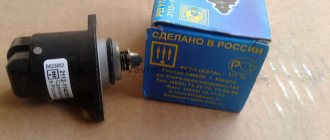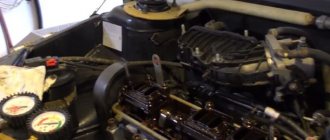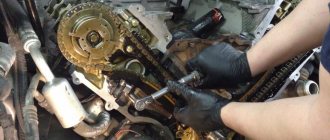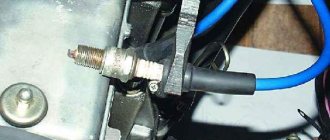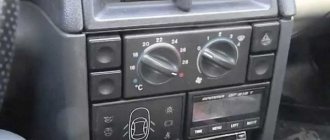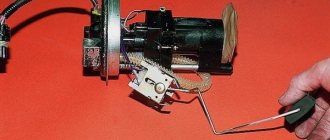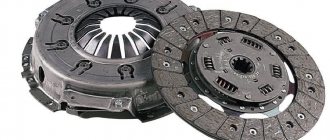VAZ 2110 8 valve injector stalls at idle - causes and solutions
The first VAZ-2110 was produced in 1995. At first it was equipped with a carburetor engine with 8 valves, and then only injection engines began to be installed on it. This model was produced in sedans, hatchbacks, and even station wagons. In 2007, they stopped being produced in Tolyatti, but began to be produced in Ukraine.
If a car suddenly stalls, it is always dangerous. It’s better not to allow this to happen, but if this has already happened, you need to look for the problem and solve it. In order to understand why the VAZ-2110 does not move without the help of car service specialists and wasting money, you need to have at least a little idea of which unit you need to look into, which sensors you need to check. There are many special thematic forums on the Internet where people discuss their cars and give each other advice on any problems. There you can find answers to your questions, and on YouTube you can also see it clearly.
VAZ 2110 8-valve injector does not start, the starter turns: reasons
The structure of any car is complex. Domestic models are no exception. VAZ cars, like others, may experience unexpected breakdowns. Most often, they lead to the malfunction of all mechanisms, and sometimes to their failure altogether. Some car owners are faced with a problem - the VAZ 2110 8-valve injector does not start, the starter turns. The causes of failure and repair will be discussed below.
Often this problem occurs due to a battery that has become unusable. However, if the battery is fully charged and in good condition, then the breakdown is not related to it.
Methods for diagnosing the idle air regulator (IAC)
The most common cause of the described problem, as well as the fact that the car cannot be started at all, is a malfunction of an engine part such as the idle air control. This happens most often on domestically produced cars. There are several possible situations where an IAC malfunction may occur. While the car is moving, a short-term stop occurs, as a result of which the engine stalls when hot immediately after it starts, or refuses to start at all.
After the engine has started, normal idle speed is restored only when the gas pedal is pressed at least once. Observation of similar behavior is possible with a cold engine. The initial attempt to start the engine is unsuccessful, normal operation is restored only after pressing the gas pedal.
In different situations, it may be enough to either press the pedal once or hold it until the engine warms up. An IAC malfunction may occur during sudden braking, when the engine stalls unexpectedly, and restarting shows a normal idle speed above 1500 and within 2000 rpm.
If this is the case with your car, you can try washing the IAC and throttle assembly using a special solution. If the problems do not go away, the idle air control will have to be replaced. Over time, some components may wear out naturally.
Incorrect engine operation at idle
More questions arise if the engine suddenly stalls at idle. There are several possible faults that could cause this type of problem. You can check all of them yourself in your garage.
The first thing to check is the idle speed sensor. Since it is connected to the engine, its incorrect readings can disrupt the system. It is worth checking that it is connected correctly and is working properly. The device must be replaced if there is damage to the housing.
It is very easy to check the functionality of the sensor:
No less problematic is the throttle valve assembly. If it is clogged, similar problems arise as when the fuel channels are clogged, and the engine sometimes stalls. Clean the throttle valve. If this does not solve the problem, check the condition of the throttle sensor. Its malfunction also leads to incorrect operation of the engine unit, so replacement or repair will help solve the problem.
Problems on the go
Now it’s time to deal with the problems that arise on the road. It happens that the engine stalls while driving. In this case, it is best to call a tow truck or enlist the help of other drivers to deliver the car to a garage or the nearest service station.
If you have some skills in handling cars, then you can check several suspected problem components and parts yourself:
- Spark plugs - they are almost always checked. If they are not working, replace them with new ones.
- A dirty fuel filter blocks the flow of fluid, resulting in a lack of fuel causing the engine to stop working. Check the filter, clean or replace it.
- The air filter may also become clogged. If this is the problem, you will notice not only unstable operation of the engine unit, but also a significant decrease in engine power, which occurs due to the fact that there is not enough air to create a high-quality combustible mixture.
- Serious problems can arise if the fuel pump is faulty. Insufficient pressure appears in the system, and the car begins to stall due to poor fuel flow into the combustion chamber. Check, repair or replace the part.
- The battery is another element that is very rarely checked after the engine is stopped. The operation of electronic devices rests on it; as soon as it is discharged, the machine will stop. The contacts of the device may also be oxidized, but they can be easily cleaned.
- After the battery, it is worth checking the generator. This could be the reason why the battery is discharged. The battery will have to be charged, and the generator will have to be repaired or replaced with a new one.
Troubleshooting options
It is clear that if any emergency situations arise with the motor, it is advisable to contact a specialized service. However, this procedure is not always possible. Therefore, it is worth knowing how to independently diagnose the main systems and key parts.
Throttle valve and assembly
When the speed drops at idle and the car stalls, you need to pay close attention to the details of the throttle assembly. Long-term operation of the car on low-quality fuel and untimely maintenance of the air filter can lead to malfunctions of the throttle valve. It periodically jams if debris gets into the equipment.
Throttle valve VAZ 2112
The problem can be solved by cleaning the system. The throttle is cleaned using carburetor cleaners. Using a compressor, you need to blow out the damper under the pressure of compressed air. It is not recommended to touch the screws located inside and on the side. If cleaning does not correct the situation, the device must be replaced. This operation is not particularly difficult.
Crankcase malfunction
There is an oil trap in the crankcase ventilation system of the engine. Its contamination can also lead to interruptions in engine operation. Crankcase gases do not allow the engine to function normally, the speed fluctuates, the internal combustion engine stalls.
Sensors
If a gasoline car stalls at idle, then one of the sensors is likely to break. In injection cars with an electronic engine control system, the engine usually starts normally, but then it stops working. It's worth checking here:
- Electronic car indicators;
- DRХХ – device that regulates idle speed;
- Air flow meter (air intake in the carburetor);
- Sensor indicating the position of the throttle curtain.
Electronic control unit in VAZ 2114
Interruptions in the operation of any sensors immediately affect the behavior of the electronics - errors appear in the car control unit. The “brains” of the machine receive unreliable information. It is not transmitted correctly to the engine. It starts working with parameters that do not correspond to reality. Self-testing of this device is not possible. You need to contact a professional for service.
Diagnostics of mass air flow sensor
The idle air control device is usually to blame for engine malfunction when the car idles poorly. But you pressed the gas pedal and the engine started. In the latest VAZ modifications, error information appears on the instrument panel.
When diagnosing, you must use a multimeter. If a part is faulty, it is recommended to replace it with a new one. All sensors are reasonably priced. It is better to start checking with parts that have a simpler design. Then gradually move on to complex devices. We must not forget that the problem may lie not only in the sensors themselves. It is also necessary to check the wiring to them and the presence of stable contact.
Carburetor
If the VAZ carburetor stalls at idle speed, then the jets may become clogged. Low-quality gasoline, deposits from the gas tank, contain small particles of debris. They can easily disrupt the operation of the fuel injection system. It is worth replacing the filter in front of the carburetor and cleaning the device itself. The dispensing part is cleaned using a cleaning solvent, which is sold in aerosol cans. Another reason is often a prolonged lack of carburetor adjustment.
In a mechanical fuel pump of carburetor cars, the filter mesh may be clogged with dirt. This reduces the performance of the device. Wear of the membrane and its destruction often leads to clogged carburetor channels.
Why does the VAZ-2112 stall while driving? We know!
There may be several reasons for such a malfunction, which have the same symptoms and different ways to eliminate them. We will tell you about the most common ones that are found on the VAZ-2112, and we will tell you how to fix them.
Throttle valve
Inspect this element for traces of carbon deposits and clean it with carburetor cleaner. To achieve the best effect, work should be carried out on a dismantled element.
Throttle position sensor
A small element attached to the throttle body is also the cause of engine failure with such symptoms on VAZ-2112 cars. The thing is that when the throttle position sensor is faulty, it is not able to transmit the command to open idle in time. Thus, the system thinks that the driver continues to press the gas pedal, making the air supply minimal. Based on this, the engine simply stalls at idle and starts again after turning the key again.
The sensor is located here
Ignition system
Pay attention to the condition of the ignition module (article on module repair here), high-voltage wires and spark plugs. If there are traces of corrosion, melting on their surface, or there are cracks on the body, this will only mean that each of the above elements will require replacement, since they cannot be repaired or corrected. In order to correctly approach the issue of choosing spark plugs for the VAZ-2112, you can read this article.
First we check the wires, and then the spark plugs.
Supply system
In this case, check all the wires coming from the battery, generator and ECU. Since even the slightest short to ground of the power wires can shut down the engine.
Fuel pump and grid
It is possible that a large amount of deposits has formed on the mesh, which is located directly in the gas tank, and while driving the required amount of fuel simply does not reach the engine, the gas pump does not pump with the required force, which causes the engine to stall. The fuel pump screen needs to be cleaned or replaced.
The difference between the new grid and the old one.
Idle speed sensor close up on an editorial VAZ-2112
Although such a cause of malfunction is not inherent in this sensor, if it has not been checked for a long time, it should not be ignored. If there are deposits on it, then it should be cleaned; if there is mechanical damage, then replace it. How to do this correctly is written in this article.
Why does it start and stall?
If you turn on the logic, there may be several main reasons why the engine stalled after starting:
- insufficient amount of fuel;
- exhaust system malfunctions;
- failures in the formation of the air-fuel mixture and its supply to the injectors.
It can be assumed that the cause is faulty spark plugs or a clogged air filter. But spark plugs do not all fail at once. If one spark plug does not work, the engine starts to stall, but this will not cause it to stall. To clog the filter to such an extent that it is unable to pass air through itself requires a lot of effort. When there is no air supply, the engine will not start at all, and even if it does start, the thrust will drop significantly. Traveling would be difficult, if not impossible.
Insufficient fuel supply
The symptom is simple: after starting, the engine runs for 5–10 seconds and stalls. In most cases, the cause is the fuel pump located in the fuel tank. To be precise, the problem is a clogged fine filter or mesh. This detail, insignificant at first glance, does not allow dirt particles to enter the fuel line, which, like water in the gas tank, is abundant (especially on cars with a mileage of 50,000 or more).
In summer, the water and other substances in the tank are liquid and can pass into the main line, but in winter they often turn into ice on the mesh filter. This causes the fuel pump to be unable to pump enough fuel to run the engine. Therefore, it turns out that the pump manages to pump a little fuel, and this is just enough to start the engine, but no more. To eliminate this problem, it is enough to replace or clean the fuel pump mesh.
Exhaust system malfunctions
Everything is simple here: if you close the pipe tightly, the engine will stall after some time. Even if you start it again, it will run for a few seconds and then die again. This happens because the exhaust gases have nowhere to go: they cannot get out, and fall through the exhaust manifold back into the combustion chambers. There, the gases mix with the air-fuel mixture, ignition becomes impossible, and the engine stalls.
Exhaust gases are not removed for several reasons:
- catalyst malfunction (can also be heavily contaminated);
- water in the muffler.
The situation with a clogged catalyst is rare. To do this, the water in it needs to freeze, but this is unlikely.
But water in the muffler happens quite often. It freezes in winter and exhaust gases cannot escape. There are few reasons why water gets in. Basically, this is a broken cylinder head, which causes antifreeze to enter the exhaust system and, mixing with condensate, freezes. Although, if the cylinder head gasket is punctured, the problem of ice in the muffler will seem like a trifle, since more serious repairs await.
Incorrect fuel/air mixture
Such situations occur frequently. In this case, the engine either does not start at all, or runs erratically. There are few reasons, these are:
- incorrect operation of the throttle assembly;
- air intake in addition to the air duct in front of the air filter (suction).
The throttle valve is directly involved in the formation of the fuel mixture, and disruption of its functioning leads to malfunctions of the power plant. The air leak makes the mixture too lean, and the engine cannot work on it, which is why it stalls. To eliminate these problems, you need to clean the throttle assembly (or replace it if it is faulty) and look for the location of the air leak.
If the engine does not start: troubleshooting methods
If the most unpleasant thing happens, you should not make useless attempts and only discharge the battery by rotating the crankshaft. You may still need a charge of electricity if you succeed in repairing the car. At least for the starter to work.
First of all, you need to check whether the fuel pump is working , whether there is enough fuel, whether the ignition works. Maybe the problem is in the injectors that have failed, but this happens very rarely. Their O-rings, vacuum hoses, and gaskets wear out more often. The same goes for the electronic control unit (ECU), for the most part it works properly for a long time.
The fuel pump and its operation are controlled by sound . If it is missing, it is important to ensure that the wiring is in good condition. The sufficient voltage supplied to the fuel pump is 12 V. The pressure created during its operation by the fuel supply system should be about 2-3 bar.
When fuel stops flowing, the pressure drop occurs over time, not immediately. If this happens almost immediately, then you need to check the fuel regulator, unless, of course, it is leaking. You can turn off the fuel pressure regulator for a short time to make sure the system is working.
To check the ignition, the spark plug is connected to the ground as carefully as possible so that the computer does not burn out. The condition of the spark plugs can cause the car to stall while driving, but this happens quite rarely. The integrity of the wiring and shielding play a big role in the performance of the synchronization sensor and when testing it.
All connections that may affect the operation of the computer should be checked . There is a good chance that there is a disconnect somewhere. In this case, a good signal of operability is the illumination of the Check Engine indicator. If it exists, then there is still hope. However, cars produced by VAZ do not allow you to determine the error code and, accordingly, localize the fault without using a tester.
A large number of errors most likely indicates a completely detached part. Next, you should measure the voltage supplied to the network. Typically, a running engine consumes 14 V, its cranking results in a voltage of 8 V, and an idle one - 12.5 V. You should definitely make sure that the drive belt and camshaft are intact, which will not be very difficult.
Finally, you should completely disconnect everything from the ECU except the crankshaft timing sensor, but if you do not understand the actions being performed, it is better not to risk it. If the VAZ 2110 stalls after the work done above, you need to check how clogged the air filter is. If it has not been replaced or cleaned for a long time, it is better to do it right now.
It wouldn’t hurt to check the fuel pump, as mentioned earlier, compare the actual coolant temperature with the sensor readings (a deviation of 5 °C is allowed), as well as the voltage. In addition, it is worth wiggling the various connectors. This may seem funny and absurd, but it happens that the reason is precisely a poor connection. Finally, you should inspect the camshaft belt.
Almost all drivers can perform the list of actions described. There may be several reasons why the VAZ 2110 stalls while driving, and not all of them are easily identified. Simply moving the wires can help, and in some cases you will need to go to a car service center if simple steps do not help solve the problem and prevent its further manifestations.
Didn't find the information you are looking for? on our forum.
The car stalled on the road and won't start.
- Thank you
- I do not like
Evgeniy_K July 26, 2008
Hello everyone, it's me again.
VAZ 2110 '05 1.6i 8cl. 40 thousand km
I was driving home, the gas light was on, I filled it up for 500 rubles at my trusted gas station, I drove off, after a couple of kilometers on a turn while switching to second - it stalled, I turned the ignition key - it started, stuck the second one in (because it was still rolling by inertia), clutch, grabbed let's move on. after a couple of kilometers the same garbage. I pulled the ignition, released the clutch, grabbed it in gear, and drove off. And finally, for the third time, it stalled while driving when the clutch pedal was pressed and would not start again. All the way, without straining, the temperature stayed at 90. The starter turns, and when the starter is running, the oil pressure light and the check engine light go out. The engine won't start. Neither with the gas pedal to the floor, nor as usual. I disconnected the terminal from the battery for 15 minutes, it didn’t help. There, in the field, they checked what they could: all the fluids are in place, there is gasoline in the ramp, there is pressure on the eye, the fuel pump turns and delivers gasoline when the ignition is turned on, the fuel pump relay clicks properly, there is a spark on the turned-out spark plug, but the spark plug is dry, like teeth from a hangover. and this after several attempts to start. Gasoline was drained from the ramp to visually check for impurities. The gasoline looks normal, homogeneous, no water is visible. After 20 minutes of stupidly listening to music and waiting for a friend with a tie, I reacted positively to the next attempt to start, grabbed it and worked for a minute, revved it up, the speed was picking up, but I don’t like the sound of the engine, it’s not native. It stalled on its own and would not start again. They dragged it to the parking lot. Have your brains gone missing? I don’t understand at all.
Tell me, maybe someone had something similar, huh?
Z.Y. I wiped the headlights and knocked on the wheel, it doesn’t help.
- Thank you
- I do not like
Caesar July 27, 2008
Hello everyone, it's me again.
VAZ 2110 '05 1.6i 8cl. 40 thousand km
I was driving home, the gas light was on, I filled it up for 500 rubles at my trusted gas station, I drove off, after a couple of kilometers on a turn while switching to second - it stalled, I turned the ignition key - it started, stuck the second one in (because it was still rolling by inertia), clutch, grabbed let's move on. after a couple of kilometers the same garbage. I pulled the ignition, released the clutch, grabbed it in gear, and drove off. And finally, for the third time, it stalled while driving when the clutch pedal was pressed and would not start again. All the way, without straining, the temperature stayed at 90. The starter turns, and when the starter is running, the oil pressure light and the check engine light go out. The engine won't start. Neither with the gas pedal to the floor, nor as usual. I disconnected the terminal from the battery for 15 minutes, it didn’t help. There, in the field, they checked what they could: all the fluids are in place, there is gasoline in the ramp, there is pressure on the eye, the fuel pump turns and delivers gasoline when the ignition is turned on, the fuel pump relay clicks properly, there is a spark on the turned-out spark plug, but the spark plug is dry, like teeth from a hangover. and this after several attempts to start. Gasoline was drained from the ramp to visually check for impurities. The gasoline looks normal, homogeneous, no water is visible. After 20 minutes of stupidly listening to music and waiting for a friend with a tie, I reacted positively to the next attempt to start, grabbed it and worked for a minute, revved it up, the speed was picking up, but I don’t like the sound of the engine, it’s not native. It stalled on its own and would not start again. They dragged it to the parking lot. Have your brains gone missing? I don’t understand at all.
Tell me, maybe someone had something similar, huh?
Z.Y. I wiped the headlights and knocked on the wheel, it doesn’t help.
Hello! Look at the timing belt and block (wires) of the crankshaft position sensor, located at the bottom right near the generator pulley.
- Thank you
- I do not like
ValinoG July 27, 2008
- Thank you
- I do not like
Evgeniy_K July 27, 2008
try to unhook the mass flow sensor and start it. If that doesn’t help, then look at the air flow sensor and the pressure regulator
I found the DPKV myself, what should I look at in it? Mass air flow sensor - it’s worse with this one, where is it and what does it look like? IAC and RD - “I heard a ringing, but I don’t know where it is” - the same would be to know where they hang and how to understand that they are faulty?
- Thank you
- I do not like
Evgeniy_K July 28, 2008
- Thank you
- I do not like
Caesar July 28, 2008
In general, I found all the sensors, except for the fuel pressure regulator, it is not on the ramp. Found it thanks to here I removed everything, checked it, cleaned it. The old owner came and found me engaged in an intimate activity: I stood with the tester on the contacts of the removed DPKV and waved a screwdriver near the nose of the DPKV, watching the reaction. The sensor is alive, the old owner is in shock. muttered something about “. aspiring proctologist...” The wires (those that often rot) from the DPKV are alive and show 98 kOhm. As I understand it, the scheme is in the brain, not the essence, the main thing is not a break. I collected everything in the hope of later finding a pressure gauge and looking at the pressure in the ramp. Damn, it splashes! There is gasoline, but it doesn’t go into the pots. The guy got behind the wheel and played with the alarm key fob. pressed and held the buttons pressed. something beeped... He turned it, started it and smiled triumphantly. It turned out that the signaling system, a bitch that we had not thoroughly studied (to our shame), went into some kind of tricky mode and did not give life to the distributor. Mosk obeyed and did not turn on the injectors. It was decided to smoke the manual for the signaling. Plus, I disassembled and cleaned the throttle block, sensors, and connectors on the sensors.
Hello! Look for the place where in the wiring to the injectors or the ignition module the wires through the signaling are broken; often in “bad” salons, when installing the alarm, all the wires are twisted with electrical tape, without being done as required through crimping and contact groups. Over time, it all falls apart and, as usual, in winter, at night and far from home. If you don’t cut it yourself, then take a recommendation from a good electrician so that he can see what’s what. It’s understandable that the signals are buggy. All alarms are quite sensitive to the supply voltage, the battery must always be sufficiently charged, but the alarm itself can also malfunction, especially if it’s sophisticated—learn how to do the initial installation correctly. Good luck!
Fuel pump
Due to a faulty fuel pump, the car may operate normally for a while, then stall. Interruptions begin in the mechanism, fuel does not enter the chambers or arrives in small quantities. Initially, the engine will run at idle, as the speed increases, it will stall, and when the pump finally fails, it will not start.
The fuel pump is easy to repair, but the breakdown may recur, so it is better to replace it. This unit is located under the rear seat.
In summer, the fuel pump may operate intermittently due to fuel boiling. This happens on classic Soviet cars. To get rid of the problem, you have to turn off the engine and wait until the fuel cools down.
Testing the mass air flow sensor (MAF)
Let us remind you what we are talking about - VAZ-2110 8-valve injector: the speed drops and stalls. A reasonable question arises: what to do? If the reason is not the IAC, then it is worth testing the mass air flow sensor. Here are some recommendations on how to do this:
- Disconnect the sensor connector from the on-board system. The controller that controls the engine will operate in emergency mode, but for short testing this is not fatal. If your car runs much faster, then the problem is most likely in the mass air flow sensor. It's time to clean it.
- Replace the sensor with a working one, and then see how the engine works. There are improvements, which means you need to either clean or replace your own mass air flow sensor.
- It also makes sense to inspect the air intake; to do this, you need to remove the mounting clamp and carefully inspect the inside of the air intake, there should be no condensation or oil there. If any are found, then it will have to be cleaned with special means.
- You can also test the mass air flow sensor using a multimeter. To do this, you need to switch the multimeter to voltmeter mode and set it to 2. The sensor has 2 wires - yellow and green. Yellow transmits a signal to the controller, and green transmits a signal to ground. When the ignition is turned on, we take measurements between these two wires. The engine should not be running. If the readings are in the range of 1.01-1.02, then the sensor is in perfect order. Readings in the range of 1.02-1.03 – it’s time to clean the sensor. And if the indicators go off scale to 1.04, then it’s time to get a new sensor.
Now we have figured out the main symptoms of a malfunction of the mass air flow sensor; neither testing nor troubleshooting is particularly difficult. It is quite possible to cope without after-sales service.
Why does the car stall when braking: the main reasons for the engine stopping
Many car enthusiasts, when starting the engine, believe that it works without any problems and immediately gains the necessary characteristics for uninterrupted operation. After a short warm-up, the car starts normally, but when braking, it stalls, most often at the moment when the clutch is depressed.
To understand the situation, just look at the tachometer or listen to the sound of the engine. When you press the clutch, the speed drops abruptly to a minimum level at which the engine stalls. Moreover, such a problem may occur only occasionally, which complicates the identification of the malfunction. The engine may stall when braking without pressing the clutch, or simply when braking the engine.
From this we can conclude that the car stalls in transient modes when the gas pedal is released and the throttle valve closes. At this moment, the idle system begins to work, but this does not mean that it alone is responsible for the problem that has arisen.
If the car stalls while braking, the first thing to check is the condition of the braking system. To do this, you need to pump the pedal five to six times and leave it depressed to the bottom point. This is done with the engine off, after which it starts, and the pedal should rise to its normal functional state, and the brakes should engage normally. If this does not happen, the brake system needs to be diagnosed and repaired.
Experts include the following reasons why the engine stalls when braking:
- breakdown of the brake vacuum booster, its depressurization;
- a burst and depressurized vacuum booster hose;
- in engines with fuel injection, the idle speed sensor may fail;
- failure or problems with adjusting the throttle position sensor or its clogging;
- tank clogging or fuel pump failure.
Breakdown of the vacuum brake booster (VUT)
This unit reduces the force exerted by the driver's foot on the brake pedal. It is located in front of the master cylinder and consists of a vacuum hose and an intake manifold. Its design includes a flexible membrane or VUT diaphragm. With fast and sharp braking, even microscopic depressurization of the vacuum booster leads to problems.
During operation, the membrane periodically moves back and forth. As a result of wear, it stretches in the middle part and cracks, allowing air to pass through. It is no longer able to create a vacuum, and air enters the fuel mixture, disturbing its balance. To identify problems with the diaphragm, you will need to do several simple procedures:
- Turn off the engine.
- Press the brake pedal up to 6 times, “pumping” it, with each new press the pedal stroke should become tighter.
- Keep the pedal pressed and start the car engine.
- If the pedal “falls through” when the engine is running, the brake booster works normally; if the pedal does not respond, this is a sign of a ruptured membrane, and the problem must be solved urgently.
The serviceability of the VUT diaphragm can be checked in another simple way:
- the car starts and runs for several minutes, then the brake pedal is pressed;
- the car engine turns off;
- it is held pressed for at least half a minute;
- the pedal must remain pressed and not try to rise, but if it rises or resists your foot, the vacuum booster of the brake system is faulty.
Video: What to do if the engine stalls when you press the brake pedal? (Do it yourself repair)
Depressurization of the vacuum booster hose
This hose serves to connect the amplifier to the intake manifold. Violation of its integrity may cause the engine to stall during sudden braking. As a result of wear or mechanical damage, cracks appear in the hose, into which air enters. The result is a violation of the proportion of the air-fuel mixture for the engine, for which the intake manifold is responsible. When you press the brake, especially sharply, it becomes critically lean, the engine speed drops and it stalls.
Checking the hose is quite simple. It is disconnected directly from the VUT, the car starts, and the hole is tightly closed with a finger. If the hose is intact, the engine speed will increase noticeably; if breaks and cracks appear, it will continue to suck in air and the speed will remain at the same level.
What to do
Diagnostics consists of several stages, taking the form of a visual examination:
- Checking the filling status of the tank with gasoline.
- Fuel pump operation.
- Filter cleanliness.
- Cleanliness of fuel injectors.
- The ignition system is working properly.
- Serviceability of the electronic control unit.
Insufficient amount of gasoline in the fuel tank is the most common reason for engine stopping. Experienced drivers know that the gas tank level arrow readings should not always be trusted, especially when it comes to older models.
The second most common reason that requires appropriate diagnostics is failure of the fuel pump. As a result of a breakdown, the device stops pumping the combustible mixture into the engine. In addition to a visual inspection, the problem is also revealed by the characteristic buzzing sounds made by the pump’s electric motor, which it makes even after the ignition is turned off. Additionally, the condition of the device is checked using a pressure gauge - its readings must be at least 2.7 atmospheres.
A clogged filter means that even with a working pump, fuel cannot flow to the engine. The filter element of good devices does not allow even the smallest particles of debris to pass through, which are contained in almost any fuel, but as a result it becomes dirty quite quickly.
The cleanliness check is carried out using the starter turned on - it is activated by first removing the hose coming from the filter. If a stream of gasoline flows, everything is in order; when not, the filter element needs to be replaced. Not only the filter, but also the injectors can become clogged easily, especially if the fuel quality is average or lower. To diagnose them, remove the ramp and move it aside. Crank the starter - during normal operation of the system, the nozzles spray the combustible mixture. If there is no such effect, then the driver has encountered a breakdown.
The ignition system is a problematic element in the fuel system of a car. When there is no spark, the engine will not be able to work. But more often it does not exist due to breakdowns of the wire or spark plugs, thanks to which a spark occurs and its strength is sufficient to initiate the operation of the power plant. Visually, on properly working spark plugs there is no deposit on the working surface and the gap between the electrodes is sufficient. Plaque or lack of clearance directly prevents the formation of a spark.
Faulty wires often have damaged insulation, causing current charges to flow from them to the crankcase. Check the formation of a spark by first unscrewing the spark plugs and placing them on the valve cover. Having done this, the starter is turned sharply and wait for a distinct spark to appear on the electrode of the spark plugs. In case of its complete absence, replacement of the latter is required.
- crankshaft rotation speed;
- camshaft positions.
If any of them is faulty and does not give the required signal, the spark plugs cannot produce a spark. Also look at the contact connectors, which often fly out of their sockets while driving. To diagnose faults, you may need a special tester. You have a better chance of dealing with this problem if you contact a specialized service center.
The car stalled while driving and will not start
You don’t expect a sudden stop of the engine on the road from models such as Lada Kalina, Granta or Niva, Daewoo Nexia. Unfortunately, it often happens in such popular cars as Renault Logan or Ford Focus 2. For these brands, it is often associated with the banal loss of sensor contacts from the connectors while driving.
The car stalled at idle and will not start
The car owner starts the car and accelerates with the engine already warm. It seems that everything is working fine, but as soon as he stops pressing the trigger, the power plant stalls. This usually happens due to:
- throttle valve clogged;
- throttle sensor failure;
- air filter clogged;
- idle speed sensor failure;
- poor quality fuel.
Of the above, problems with sensors can only be solved by replacing them. Throttle valve failures are determined by floating speed.
The car crashed and stalled and would not start
If a car's engine is running rough, and then it suddenly stops starting, the problem lies in the ignition for the vast majority of vehicles. Check contacts, spark plugs and other system elements.
The engine stalls when hot and does not start until it cools down.
The headache that owners of models such as Lifan 170F or Gazelle 405 and Gazelle 2115 face first is when the car drives normally, and then suddenly stalls and after a while, having cooled down, starts again. The cause of the malfunction lies in the incorrect operation of the fuel pump and is “treated” by replacing it.
The car stalled and will not start, the starter spins at idle
Owners of Lada Priora and GAZ 2106, as well as some other brands, from time to time encounter a problem when the car stalls, does not start, and the starter spins at idle. If we exclude incidents in the form of a clogged exhaust pipe or lack of gasoline, we can identify the main reasons for what is happening:
- thickening of engine oil or freezing of diesel fuel;
- pump failure;
- rotation of the flywheel crown due to the clutch of the flywheel with the bendix;
- Bendix jamming.
These problems that prevent the car from driving can be fixed with your own hands.
The car stalled while driving and will not start, the starter does not turn
Owners of Opel cars, as well as some other brands, sometimes encounter a situation where not only the engine stalls, but the starter does not even turn when trying to start it. And in most cases, the reason lies in insufficient battery charging.
The car stalled in the water and will not start
Situations when a car stalls after driving through a puddle, although not very often, do occur. This occurs due to water splashing onto the ignition system wires and sensors. The problem can be solved by simply airing it so that the moisture evaporates. You can speed up the process in hot weather by additionally wiping the devices with a dry cloth. To avoid a recurrence of the situation, it is better to use protective equipment.
From personal practice, drivers know well that when overcoming deep puddles, the crankshaft sensor often suffers due to its low location. Just wipe it down and within a few minutes the machine will be operational again. There are also more serious problems. Some car owners have to deal with engine water hammer - water gets into the engine. When this happens, the power plant makes a sound like a pop before stalling. It is better to leave troubleshooting to specialists.
The engine stalled while driving and will not start: injector
Motors with fuel injection installed on such popular car brands as VAZ 2109, 2110, 2112, 2114 are slightly different in design compared to carburetor engines. There are some peculiarities in identifying problems that cause it to stall. More often this happens due to:
- contamination of the air flow sensor;
- contamination of the throttle assembly;
- lack of fuel pressure;
- wear or jamming of the idle air regulator;
- depressurization of the intake manifold;
- malfunctions in the ignition system.
By checking the indicated elements, diagnostics of the injector operation begins, regardless of whether it has 8 or 16 valves. In general, checking the condition of the engine of such a device is more difficult than that of a carburetor. Although there are simple cases: for example, when there is no spark.
The crankshaft sensor is a fragile element of the system and replacing it is the only way to repair it. The way to find out whether it is really faulty is to use a special multimeter, available only to specialists.
